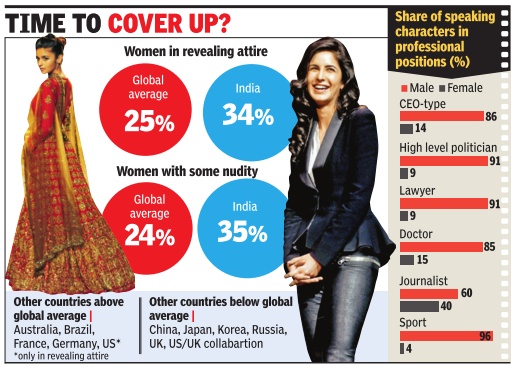Women in Indian cinema
(Created page with "{| class="wikitable" |- |colspan="0"|<div style="font-size:100%"> This is a collection of articles archived for the excellence of their content.<br/> </div> |} [[Category:Ind...") |
(→Cheesecake in India higher than global average) |
||
| Line 13: | Line 13: | ||
[[File: cheesecake.jpg| |frame|500px]] | [[File: cheesecake.jpg| |frame|500px]] | ||
'''‘It’s not a fair deal for women in Bolly’ ''' | '''‘It’s not a fair deal for women in Bolly’ ''' | ||
| − | |||
| − | [http://epaperbeta.timesofindia.com//Article.aspx?eid=31808&articlexml=Its-not-a-fair-deal-for-women-in-24092014018031 The Times of India ] Sep 24 2014 | + | Subodh Varma [http://epaperbeta.timesofindia.com//Article.aspx?eid=31808&articlexml=Its-not-a-fair-deal-for-women-in-24092014018031 The Times of India ] Sep 24 2014 |
''' 35% Of Them Shown In Revealing Clothes Against Global Average Of 25%: Study ''' | ''' 35% Of Them Shown In Revealing Clothes Against Global Average Of 25%: Study ''' | ||
Revision as of 01:04, 19 October 2014
This is a collection of articles archived for the excellence of their content. |
Cheesecake in India higher than global average
‘It’s not a fair deal for women in Bolly’
Subodh Varma The Times of India Sep 24 2014
35% Of Them Shown In Revealing Clothes Against Global Average Of 25%: Study
In the first-ever study on how women are shown in popular films in the world’s top 11 movie markets, India comes off poorly — 34% of women characters in India’s top grossers were shown wearing sexually revealing clothes against a global average of 25%, while 35% were depicted in partially nude scenes against a global average of 24%.
Only about a quarter of all speaking characters in Indian films were women as opposed to a global average of 31%.
The study analysed 120 popular films released between 2010 and 2013 across the most profitable territories internationally including Australia, Brazil, China, France, Germany, India, Japan, Russia, South Korea, United States, United Kingdom, as well as UK-US collaborations.
The study, released recent ly, was conducted by Stacy L Smith and her colleagues at the Annenberg School for Communication and Journalism, University of Southern California, for the Geena Davis Institute on Gender in Media, UN Women and The Rockefeller Foundation. “Females bring more to society than just their appearance,” said Smith, the principal investigator.
“These results illuminate that globally, we have more than a film problem when it comes to valuing girls and women. We have a human problem.” Globally, it found that just one third of all speaking characters in films are female and less than a quarter (22.5%) of the on-screen workforce were females. When the characters are employed, females are largely absent from powerful positions.
Women represent less than 15% of business executives, political figures, or science, technology, engineering, and or math (STEM) employees. Of the samples chosen, India did not have a single film with a female lead or co-lead role or a gender balanced cast.
